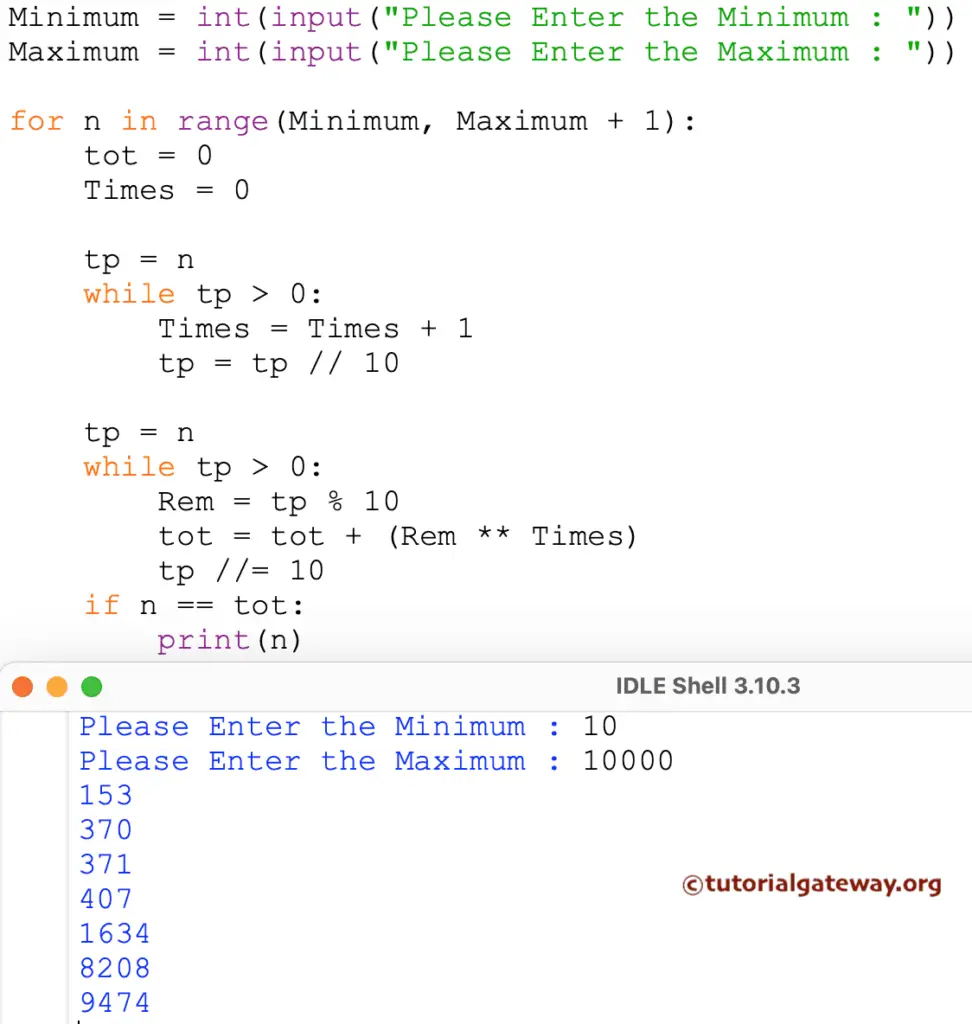How to Write Python Program For Armstrong Number Using While Loop, For Loop, Functions, and Recursion? We also show you the program to print Armstrong Numbers between 1 to n.
Python Armstrong Number: If the given number is a positive integer and it equals the sum of the Nth power of each digit present in that integer, then that can be an Armstrong—for example, 370.
Individual digits in 370 = 3
370 = 3³ + 7³ + 0³ = 27 + 343 + 0 = 370
Python Program For Armstrong Number Algorithm Steps:
The below steps show you the common approach to checks for the Armstrong Number.
- The user has to enter any number.
- Count the total individual digits (For Example, 370 means 3).
- Divide the given integer into individual digits (For Example, Divide 370 into 3, 7, and 0).
- Calculate the power of n for each individual and add them.
- Compare the original value with the Sum value.
- If they exactly matched, then it is an Armstrong. Else, it is not.
Python Program for Armstrong Number Using While Loop
This program allows the user to enter any positive integer. And then, this Python program code checks whether a number is Armstrong or Not using the While Loop.
# Using While Loop
Number = int(input("Please Enter the Number to Check: "))
Sum = 0
Times = 0
Temp = Number
while Temp > 0:
Times = Times + 1
Temp = Temp // 10
Temp = Number
while Temp > 0:
Reminder = Temp % 10
Sum = Sum + (Reminder ** Times)
Temp //= 10
if Number == Sum:
print("%d is Armstrong." %Number)
else:
print("%d is Not." %Number)
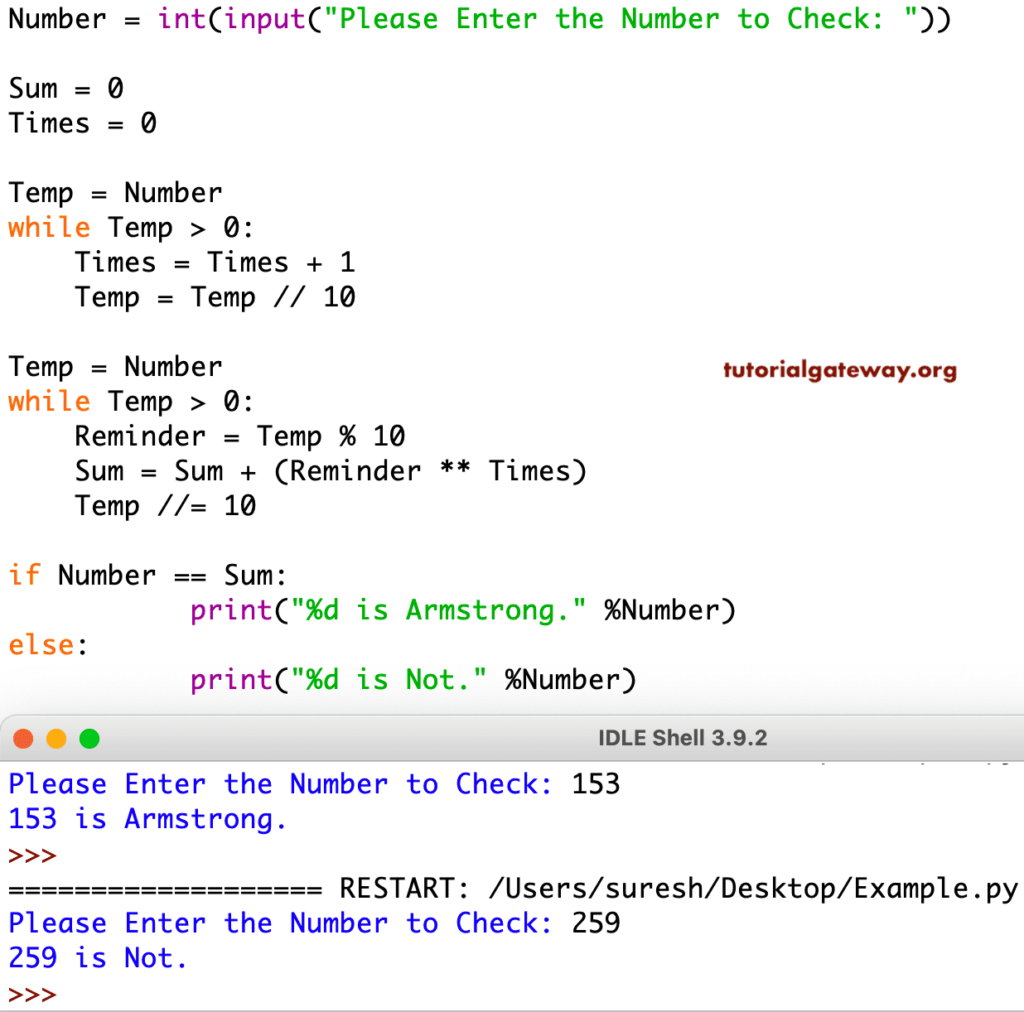
This program for Armstrong number in Python code allows the user to enter any positive integer and assign it to a variable.
Next, We assign the original value to the Temp variable. It helps to preserve our original value and then do all the manipulation on the Temp variable.
The first While Loop makes sure that the given number is greater than 0. Statements inside the while loop split it and count the individual digits inside the given integer. If you don’t understand the program logic, Please refer to the Find Total Digits article in Python.
The Second While loop of the Armstrong Number program ensures that the given integer is greater than 0. Let us see the working principle of this while loop in iteration wise
while Temp > 0: Reminder = Temp % 10 Sum = Sum + (Reminder ** Times) Temp //= 10
User Entered value for this Python Program For Armstrong Number = 9474 and Sum = 0
Temp =Number
Temp = 9474
First Iteration
Reminder = Temp %10
Reminder = 9474 % 10 = 4
Sum = Sum + pow (Reminder, Times)
For this Python Program For Armstrong Number example, Times =4 because the total digits in 9474 = 4. So,
Sum = 0 + (4 * 4 * 4 * 4) => 0 + 256 => Sum = 256
Temp = Temp /10 => 9474 /10
Temp = 947
NOTE: If the digits count is 5, then Reminder multiplied by 5 times.
Second Iteration: From the Python Program to check Armstrong Number first iteration, the values of both Temp and Sum changed as Temp = 163 and Sum = 256.
Reminder = 947 % 10 = 7
Sum = 256 + (7 * 7 * 7 * 7) => 256 + 2401 => 2657
Temp = 163 /10 = 94
Third Iteration: From the second iteration, the values of Temp = 94 and Sum = 2657.
Reminder = 94 % 10 = 4
Sum = 2657 + (4 * 4 * 4 * 4) => 2657 + 256 => 2913
Temp = 94 /10 = 9
Python Program For Armstrong Number Fourth Iteration: From the third Iteration, the values of Temp = 9 and Sum = 2913
Reminder = 9 % 10 = 0
Sum = 2913 + (9 * 9 * 9 * 9) => 2913 + 6561 => 9474
Temp = 9/10 = 0
Here, Temp = 0, so the while loop condition fails.
if(9474 == 9474), Condition checks whether the user entered is exactly equal to Sum. If this condition is True, then it is; else, it is not.
NOTE: If you are finding the number below 1000, remove the while loop to count the digits in an integer, and then replace the below code
Sum = Sum + (Reminder ** Times); With Sum = Sum + (Reminder * Reminder * Reminder)
To avoid the first while loop, in this code for Armstrong, we used the str() function to convert the number to a string and the len() function to find the total digits.
Num = int(input("Enter the Value : "))
numText = str(Num)
l = len(str(Num))
Sum = 0
Temp = Num
while Temp > 0:
Reminder = Temp % 10
Sum = Sum + (Reminder ** l)
Temp //= 10
Enter the Value : 8208
8208 is Armstrong.Python Program to find Armstrong Number using For Loop
This Python program allows the user to enter any positive integer and then checks whether a number is Armstrong or Not using For Loop.
# Using For Loop
Num = int(input("Please Enter the Value : "))
Sum = 0
Times = 0
Temp = Num
while Temp > 0:
Times = Times + 1
Temp = Temp // 10
Temp = Num
for n in range(1, Temp + 1):
Reminder = Temp % 10
Sum = Sum + (Reminder ** Times)
Temp //= 10
if Num == Sum:
print("%d is Armstrong Number." %Num)
else:
print("%d is Not." %Num)
We replaced the While loop in the above example with the For loop. If you don’t understand the for loop, then please refer to the For Loop article.
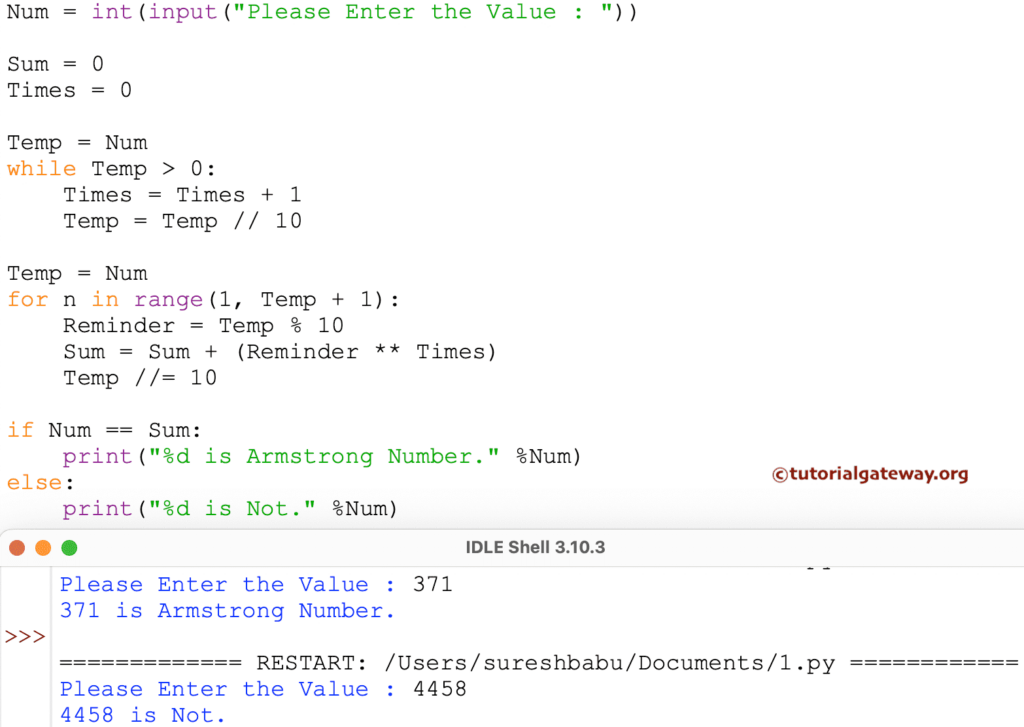
If we convert the number to a string, the len() function will get the total number of digits, and the for loop reads each digit as a character. So, we can avoid an extra while loop, finding the remainder and removing the last digit from a number.
Num = int(input("\nPlease Enter the Value : "))
numText = str(Num)
l = len(numText)
Sum = 0
for n in numText:
Sum = Sum + int(n) ** l
if Num == Sum:
print("\n %d is Armstrong Number.\n" % Num)
else:
print("\n %d is Not.\n" % Num)
Please Enter the Value : 407
407 is Armstrong Number.Python Program for Armstrong Number using List Comprehension
In this example code, we used the list comprehension and math log10 function to check the Armstrong number.
- digits = [int(i) for i in str(num)] – We used the list comprehension to read each individual digit and create a list of those digits.
- Use either len(digits) or int(math.log10(num)). Both will return the total digits.
- sum([d ** length for d in digits]) – It will calculate the power of length(total digits) for each individual. The sum()function calculates the list sum.
import math
num = int(input("Enter a number: "))
digits = [int(i) for i in str(num)]
#length =len(digits)
length = 1 + int(math.log10(num))
sum = sum([d ** length for d in digits])
if num == sum:
print(num,"is an Armstrong number.")
else:
print(num,"is not.")
Enter a number: 9992
9992 is not.
Enter a number: 8208
8208 is an Armstrong number.Python Program to Check Armstrong Number using Functions
This Python program allows users to enter any positive integer and checks whether a number is Armstrong or Not using Functions.
# Using Functions
def ArmFind(val):
total = 0
Times = 0
# Calculating individual digits
tm = val
while tm > 0:
Times = Times + 1
tm = tm // 10
tm = val
for n in range(1, tm + 1):
Reminder = tm % 10
total = total + (Reminder ** Times)
tm //= 10
return total
#User Input
val = int(input("Please Enter to Find : "))
if (val == ArmFind(val)):
print("%d is Armstrong Number." %val)
else:
print("%d is Not." %val)
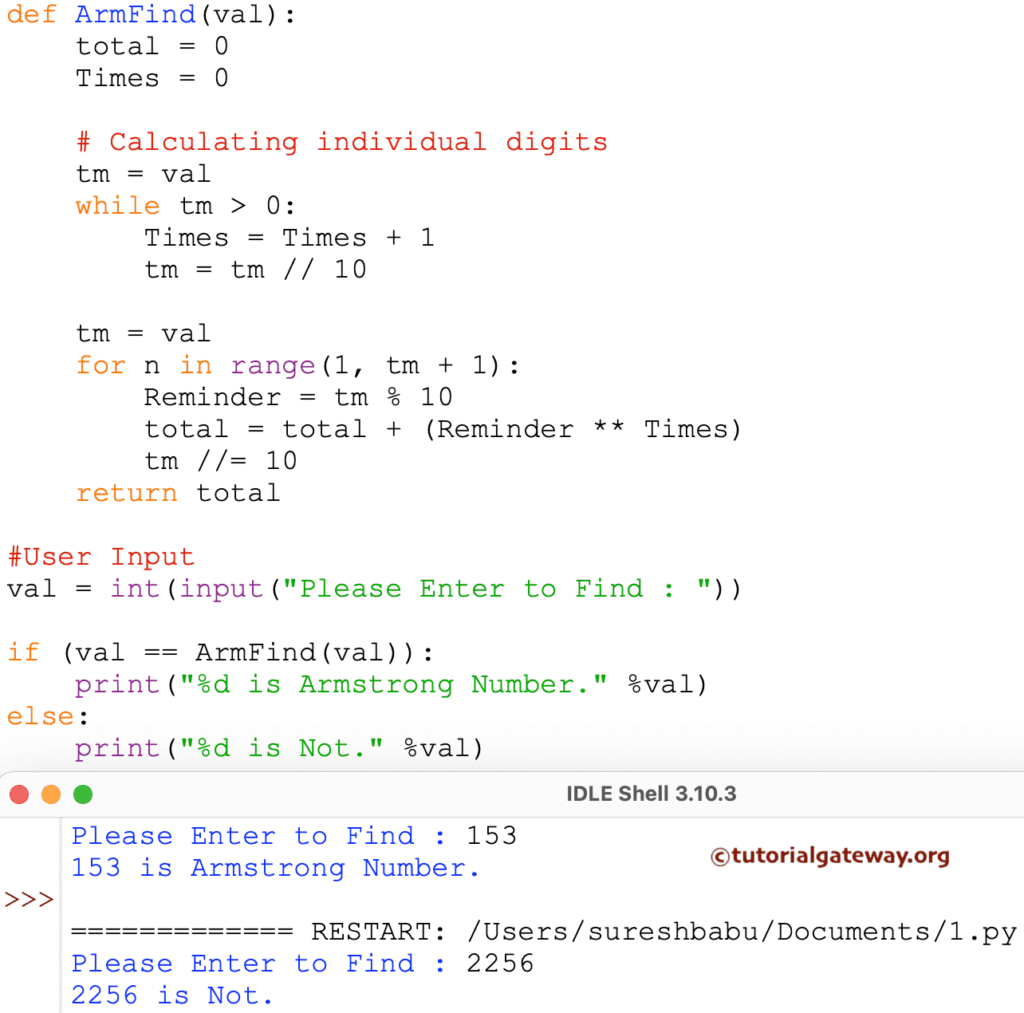
In this Python Program For the Armstrong Number example, we defined the following function to perform all the necessary calculations and return Sum.
def ArmFind(val):
When the compiler reaches the following code inside the If statement, then the compiler immediately jumps to the above-specified function.
ArmFind(val)
We have already explained the LOGIC above example.
Python Program to Check Armstrong Number using Recursion
It allows us to enter any positive integer. Next, using the recursion or recursive function concept, this Python program checks whether a number is Armstrong or Not.
# using Recursive functions
total = 0
Times = 0
def Count_Of_Digits(value):
global Times
if(value > 0):
Times = Times + 1
Count_Of_Digits(value // 10)
return Times
def ArmFind(value, Times):
global total
if(value > 0):
Reminder = value % 10
total = total + (Reminder ** Times)
ArmFind(value //10, Times)
return total
value = int(input("Please Enter the value : "))
Times = Count_Of_Digits(value)
total = ArmFind(value, Times)
if (value == total):
print("%d is Armstrong Number." %value)
else:
print("%d is Not." %value)
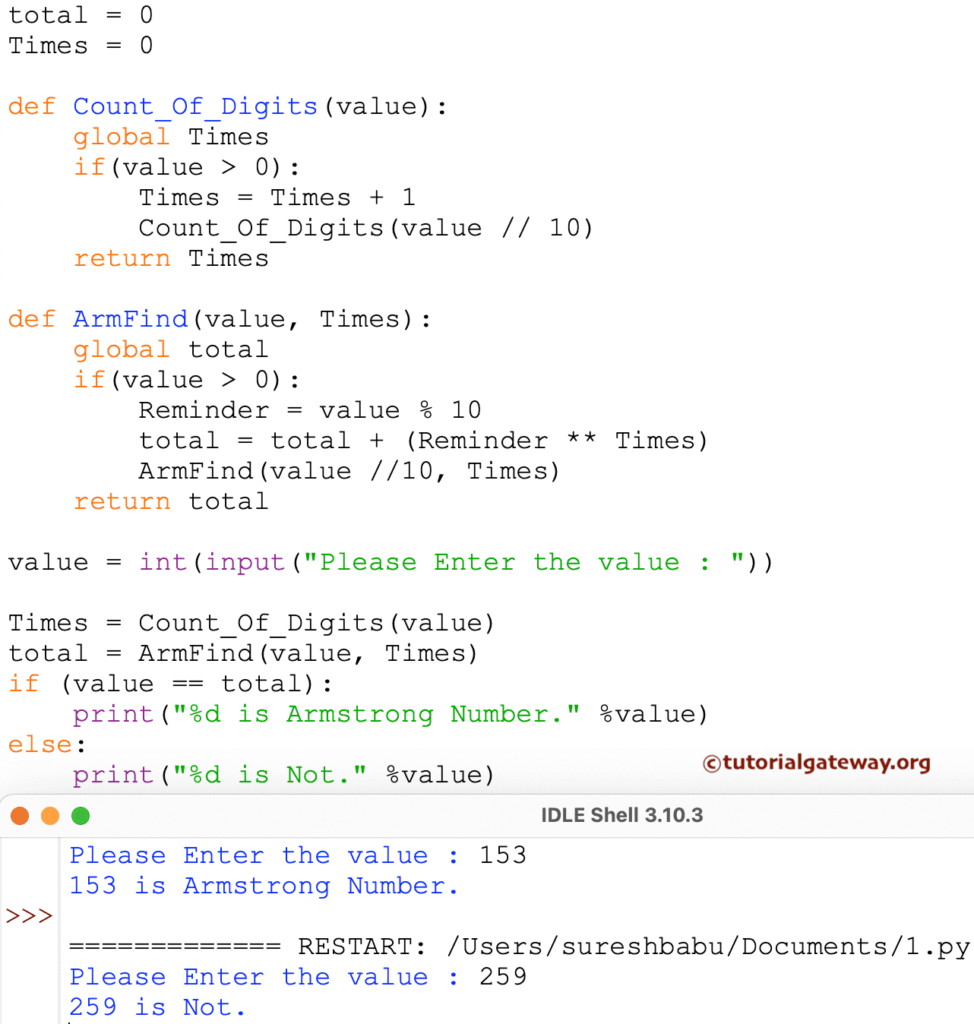
In this Python Armstrong number program example, we defined two recursive functions. The following function accepts integer values as parameter values and recursively counts the total individual digits in an integer.
def Count_Of_Digits(value):
The following function accepts two integer values as parameter values. And it performs all the necessary calculations and returns the Sum.
def ArmFind(value, Times):
The following Statement in this Python Program For Armstrong Number helps to call the function Recursively with an updated value. If you miss this statement, it will terminate after completing the first line. For example,
ArmFind(value//10, Times)
Number= 153
Then the output = 27
Let’s see the If statement inside the above-specified functions
if (value > 0) checks whether the given value is greater than 0. For Recursive functions, placing a condition before using the function recursively is essential. Otherwise, we end up in infinite execution (Same as an infinite Loop).
Python Program to Find Armstrong Numbers between the 1 to n
This program allows you to enter minimum and maximum. Then, this Python program finds and returns Armstrong Numbers between the Minimum and Maximum values.
The first two statements present in this program allow the user to enter the minimum and maximum values. The for Loop helps to iterate between Minimum and Maximum Variables. Iteration starts at the Minimum, and then it won’t exceed the Maximum variable.
if(n == tot) -– condition, check whether the sum of the power N for each digit present in that integer equals a given Value. When the condition is True, it is else it is not. If this condition is True, then it prints that integer as a result.
Minimum = int(input("Please Enter the Minimum : "))
Maximum = int(input("Please Enter the Maximum : "))
for n in range(Minimum, Maximum + 1):
tot = 0
Times = 0
tp = n
while tp > 0:
Times = Times + 1
tp = tp // 10
tp = n
while tp > 0:
Rem = tp % 10
tot = tot + (Rem ** Times)
tp //= 10
if n == tot:
print(n)
The Armstrong numbers list from 10 to 10000 output.
